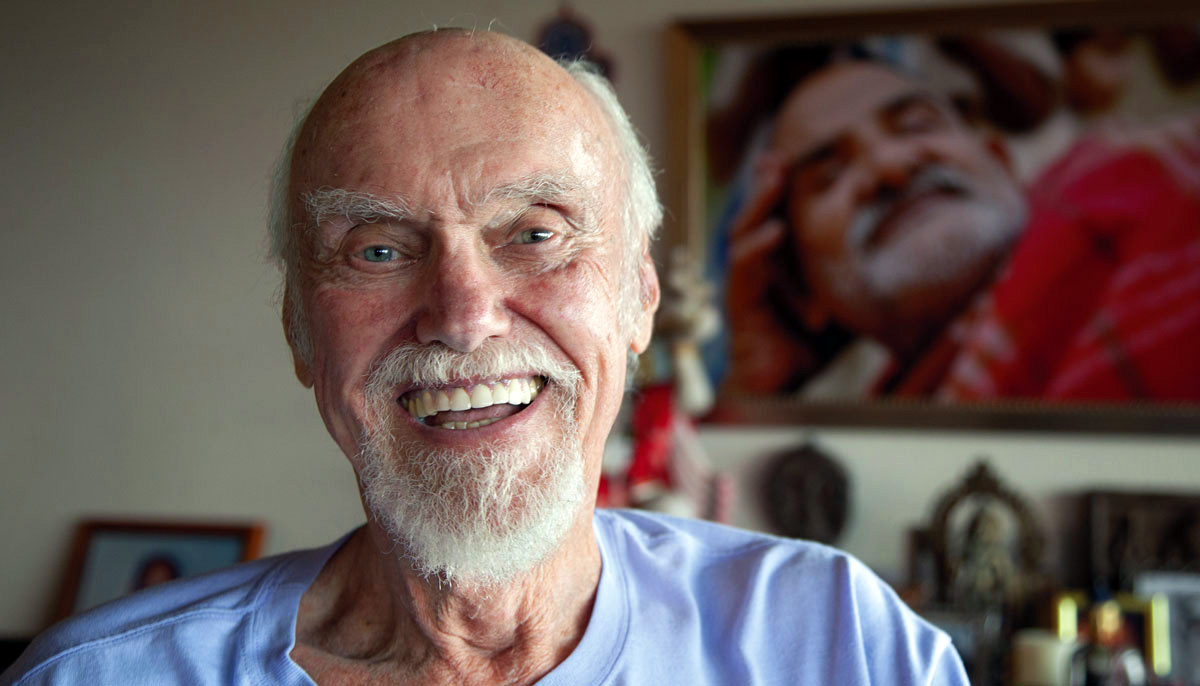I read Be Here Now and decided: I have to meet this man.
It was 1971. I was in my twenties, an agnostic, having success with my writing, and miserable. “Woe is me,” was my mantra, inherited from my Hungarian grandmother. My husband would counter: “Woe is NOT you.”
It was a time when all around me, young people were lighting out for spiritual territory, becoming vegetarians, learning to meditate and chant, and running to Chinatown to practice Tai Chi. Some of my friends were quitting their jobs to take a three-month, round-the-clock training with Oscar Ichazo of the Arica Institute, who said that after the training, they would be enlightened.
A relative started following a Hindu swami who told her to rise at four a.m., take a cold bath, and do yoga. She urged me to do the same.
That was it. I decided to investigate and expose this mass delusion, writing a piece called “The Rush for Instant Salvation” that ran on the cover of Harper’s in July 1971. But something unexpected had happened during my research. I’d found that I liked being around these gentle, spacey seekers who were working to cultivate honesty, joy, and love. But there was no way I could swallow their beliefs.
When the article was published, the editor asked if I’d resolved my ambivalence. “Yes,” I said. “I think there’s something valid in there, but I don’t know what it is.”
Then a friend gave me a square blue paperback that said on the cover: Remember Be Here Now, written by someone named Baba Ram Dass, with exotic calligraphy by artists at a New Mexico commune.
I read the text in one sitting. Ram Dass’ story matched mine: he was a “neurotic, Jewish over-achiever” who’d found at a young age that his achievements and success left him empty.
As Richard Alpert, a psychology professor at Harvard, he’d been depressed and often had to throw up before giving a lecture. But the first time he took the psychedelic mushroom psilocybin with fellow professor Timothy Leary, he watched all his roles fall away, and felt a presence—an “I”—that was at peace and all knowing. When he and Leary were fired from Harvard for experimenting with LSD, they barely broke stride, moving to upstate New York to continue their research with psychedelics. But they discovered that after each trip, each experience of higher consciousness, they’d crash back down.
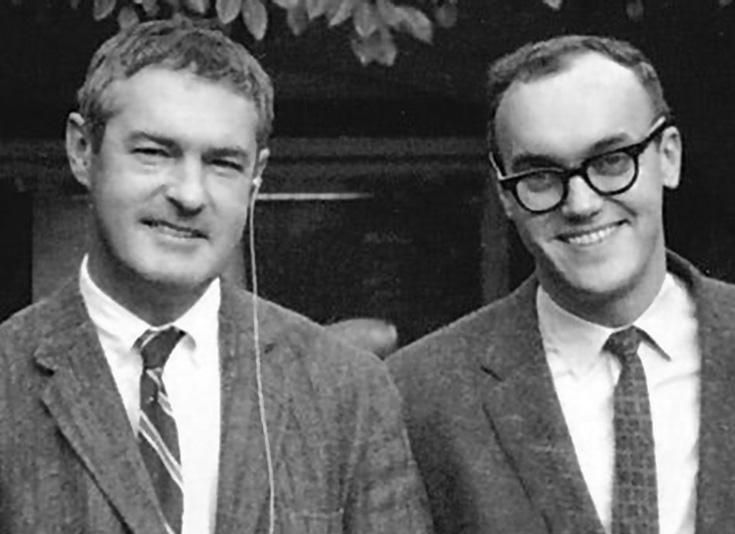
After four years, Alpert was in a state of despair, and accepted a friend’s offer to travel across India. In a story that he would be retelling the rest of his life, he met his guru, Maharaji, who named him Baba Ram Dass. Dass means servant of Ram, or God, and Baba is a term of respect and endearment for an elder (though Ram Dass was only in his thirties then)
Ram Dass spent eight months with the guru—listening, watching him, studying, and doing mental and physical practices. He was learning Bhakti Yoga, which could be summarized in one phrase: see God in everyone, love everyone, serve everyone. In 1967, the guru told him to return to the U.S., where Ram Dass started speaking, teaching, and writing Be Here Now.
Eight months! That’s all. I know people who’ve been at it for decades—meditating, working on themselves, even teaching—and they don’t embody the wisdom and charisma that Ram Dass attained in eight months.
Was he born with a gift? Was it seeded in his DNA? Carried from a past life (or some more rational equivalent)? He used to say that his ability and wisdom were grace, a gift from Maharaji, but years later, in 2004, he told me he recognized that he’d been “using Maharaji—as an explanation for why I know what I know.”
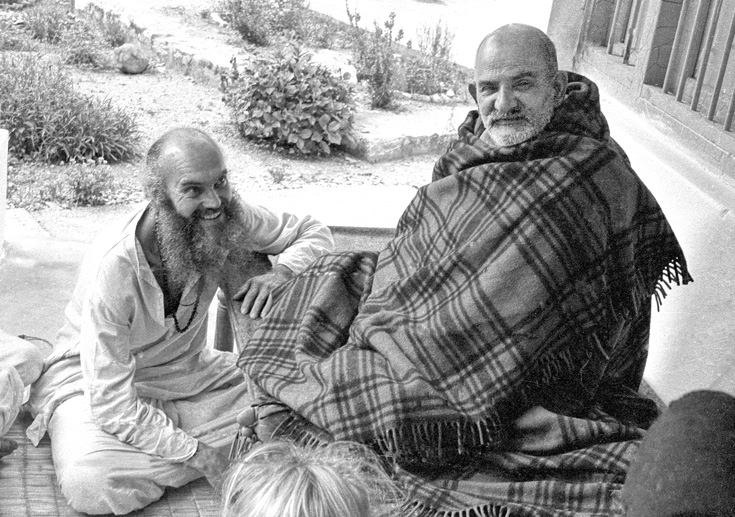
Ram Dass had always been a master at speaking; he could talk extemporaneously for hours, and convey esoteric concepts in a way that Westerners could understand. And he was funny; he’d run down Buddha’s four noble truths and have the audience laughing all the way.
As an individual, though, he wasn’t “finished” evolving. He still had bad moods and could be judgmental and waspish. But if the telephone rang and someone needed help, he would grab the phone and stay with the caller until he’d guided the person to a calmer state.
After I decided I had to meet him, I obtained an assignment from Esquire to write a profile. Ram Dass had gone back to India, so I wrote him and a few weeks later, received a reply, saying my letter “felt good” and when he was in New York we might “share a moment.”
He urged me to keep in touch through Marty Malles, who’d spent time with Maharaji in India and was a salesman of ladies’ underwear in Brooklyn. Marty took me to meditation groups and played me tapes of Ram Dass speaking. We heard rumors that he’d left India, heading for London and Scotland. We also heard that “his head was changing”—he might not speak or give interviews. After three days of futile transatlantic calls, I had an intuition, and told Marty, “I bet he’s in Boston right now, seeing his father.”
Marty picked up the phone, dialed a number, and Ram Dass answered.
“Hi,” he said to me, in a buoyant voice. “Did you finish your article?”
“No. I haven’t started it. I’d really like to see you.”
“Well,” he said, “I’m not living in time.”
“I could get in my car right now and drive to Boston.”
“You could, but you might get here and not find me.”
I said that wouldn’t bother me, but that I had heard he wanted privacy and I didn’t want to intrude. There was a long silence, and Ram Dass said, “If you can find me, you can have me.”
I was on the first shuttle flight the next morning. I had spent a sleepless night, deciding at five a.m. I couldn’t go through with it and resolving at six a.m. that I would.
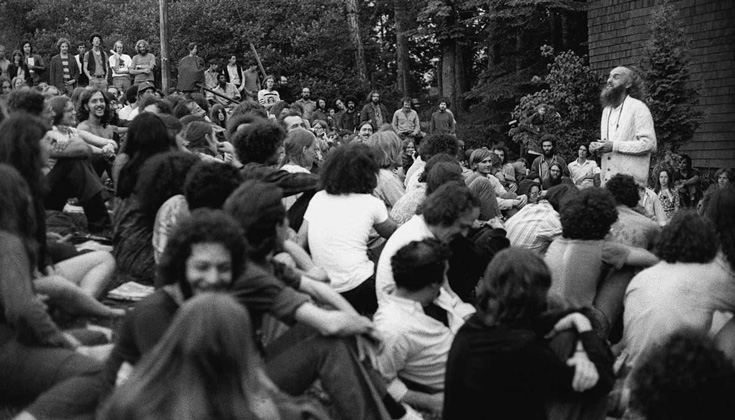
It was raining when the taxi dropped me at the townhouse in Boston owned by Ram Dass’ father, George Alpert, who’d been president of the New York, New Haven, and Hartford Railroad. I shouted through the intercom, “Is Ram Dass there?” I heard groans, shuffles. It was nine a.m. on Saturday morning, and I had woken everyone up. Ram Dass opened the door wearing a white gauze shirt and pants and a jaunty plaid cap. He was taller than I had envisioned—six foot two. His face gave off a pink glow and his blue eyes were open so wide they seemed more vertical than horizontal.
“I took you at your word,” I said.
He nodded, and led me to the library, where he’d been sleeping on a convertible sofa. “This is where I hang out.”
I interviewed him for four hours, during which he talked about being in India this time with Maharaji. At first he’d been upset that he wasn’t alone with the guru. Dozens of young Americans had followed him to Maharaji’s temple, hoping to attain what Ram Dass had found. Maharaji made Ram Dass “commander in chief of the Westerners,” and told him to love everyone and always tell the truth. But the Americans were grating on Ram Dass’ nerves. “This one was whiny, that one was selfish, one was too messy, one was too neat,” he said. “It got so that out of thirty-four people, there wasn’t one I could stand. So I thought, I’ll be truthful about it.”
He stopped speaking to them, and for two weeks wouldn’t allow any of them near him. One morning, a boy brought him some food that Maharaji had blessed and Ram Dass threw it at him.
The guru called him over and said, “Something troubling you?” Ram Dass said, “Yes, I’m angry. I hate everybody but you.” Maharaji asked why, and Ram Dass said, “because of the impurities that keep us in the illusion. I can’t stand it anymore. I can’t stand it in anybody including myself. I only love you.” Then he broke into racking sobs.
Maharaji sent for milk and sat patting Ram Dass on the head, feeding him, crying with him, and saying over and over, “You shouldn’t be angry. You should love everyone.” Ram Dass said, “But you told me to tell the truth and the truth is I hate everyone.” Maharaji said, “No. A saint doesn’t get angry. Tell the truth, and love everyone. There’s only one. Love every one.”
Ram Dass looked at the group and saw standing between him and them this huge mountain—his pride. “For me to give up the anger,” he told me, “I had to give up my whole rational position, my reasons for being angry, without sitting down first and talking it over and winning a few points for my side.”
Maharaji sent him off to eat and called the others over and said, “Ram Dass is a great saint. Go touch his feet.” This made Ram Dass cringe and feel more furious. “I saw my predicament. I was going to have to do this all myself.” He cut an apple into pieces, went to each person, and looked in that person’s eyes “until I found the place in them I loved. Then I let all the rest wash away, silently. I fed them all, and when I was finished there was no more anger. Later I got angry again, but it went through very quickly because I saw that anger is only because you’re attached to what you were thinking a moment ago. It’s not real, it’s only a mind moment. Yes I was angry then. Okay, now is now, and if you’re right here, everything starts all over again.”
It was still in the back room in Boston. Ram Dass said he was considering how best he could now serve. Maharaji had instructed him not to have ashrams, but when people managed to find Ram Dass, he would sit with them and ask questions designed to unleash the secrets and shame they were carrying inside. All the while, he’d be looking in their eyes repeating a mantra to himself. “Whatever they say gets completely neutralized the minute they bring it into my consciousness,” he said. “Because I don’t care. I know it’s not real and they feel this tremendous release.”
I wandered around Boston the rest of the day in a very unfamiliar frame of mind. This was the first time I’d heard—and understood—that thoughts and emotions were not set in concrete but more like clouds rolling by. Ordinarily, everything I saw or heard came into my awareness with a judgmental tag: that face is ugly, that color is nice, that man looks interesting. But this afternoon everything was coming in directly, without the tags. The people on the street, the orange sunset over the harbor, the piped Muzak in the elevator, the smell of frying food—everything simply was what it was, and the play of patterns, rather than any single image, was breathtaking.
I flew home the following day with thirteen hours of taped interviews and shut myself off from the world. The words poured out, sixty pages in two weeks, and I believed that everything I had written before was in preparation for this. I turned down an assignment from The New York Times Magazine to go to Cuba to interview Fidel Castro on his forty-fifth birthday. My husband said I was nuts, I was losing a major opportunity, but I felt certain this was more important to me.
When I finished the article, I dropped it at Esquire and went away for the weekend. A few days later, my editor called and asked me to come in. There were “problems,” he said. I wore a long lavender dress and my hair in a braid down my back. “You look beautiful,” he said, and I knew it was over. He fidgeted. “We can’t publish the piece. Ram Dass comes off as silly and simplistic, and your willingness to embrace his ideas is incomprehensible.” I said I’d told him in advance that this would not be a hatchet job. He shook his head. “You’ll thank us later for not printing this. It would destroy your credibility.”
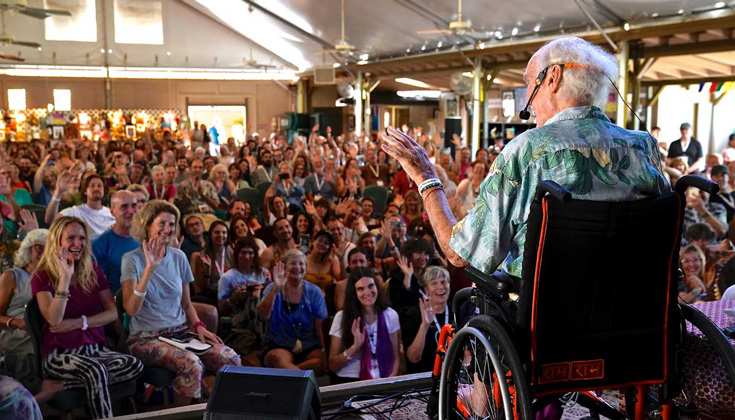
I asked my agent to send the article to other magazines, but the responses were similar: “Annoying.” “Foolish.” “We like Sara Davidson the journalist but we do not like Sara Davidson the convert.” While many of my friends were “on the path,” the gatekeepers in the publishing industry were, as I had been before, resistant, even hostile.
I decided not to write about spiritual matters again. But months later, I got a call from a colleague, Min Yee, in San Francisco who was an editor at Ramparts, the leftist political journal. He asked what I was working on.
“Well, I just spent five months working on something no one will publish.”
“Give it to me, I’ll print it,” he said.
“No you won’t.” I laughed. “It’s not for Ramparts. It’s about God.”
He told me to send it anyway, and Ramparts published the story in full. Looking back, years later, after Be Here Now had sold more than two million copies and Ram Dass had become an icon, I wondered if the editors at Ramparts had been prescient.
I stayed in touch with Ram Dass and wrote more pieces about him in the following decades. In the 1980s, the country was caught up in a fever of accumulating wealth, and many who’d been seekers turned their attention to making money and raising families. Ram Dass stayed the course, but fell off the cultural radar screen. He concentrated on service, working with the homeless, prison inmates, and people facing death, and set up a foundation to treat people with blindness in third world countries.
He wrote seven more books, and in 1997, he was working on one about aging and dying when he had a stroke. It left him with aphasia—difficulty speaking and accessing words—and his right side was paralyzed.
He rewrote the book, with a friend’s help, and when it was published in 2000, he gave a talk—speaking slowly, with many pauses—at the church of St. John the Divine in New York. It felt like a reunion of the many people he’d inspired and taught, who were now doctors, artists, teachers, and business executives. I found myself, once again, taking notes, and wrote a piece that was actually published this time—in The New York Times Magazine. The culture had caught up with Ram Dass.
With the support of caregivers, he began traveling the country again, speaking and leading retreats. He’d come to see his stroke as “fierce grace,” because it had made him more compassionate, humble, and accepting. He had constant pain on his right side and tendonitis in his left shoulder from overusing it. “But all I have to do is go inside…” he said, pointing to his chest, “and there’s peace.”
His guru had died, but Ram Dass wanted to go to India again and pulled it off, despite the wheelchair. Flying home to California, where he was living, he fell sick, but immediately left for Maui to speak at a retreat. Friends urged him not to go, but he said he didn’t want to “welch on my agreement.” At the end of the retreat, he collapsed, was rushed to the hospital with a severe infection, and nearly died. After that, he resolved not to get on an airplane again. “I’m going to die in Maui.”
I visited him there numerous times, especially in 2010 when he discovered that he had a son—a fifty-four-year-old banker in North Carolina—that he’d never known about. I wrote a Kindle single about how it had happened and the effect on Ram Dass. I was planning to visit him this February when I received word that he had died on December 22. He’d been hospitalized again with an infection that was spreading, but was back home, with his caregiver/manager, Kathleen Murphy, whom he’d named “Dassima,” and his friend and literary collaborator, Rameshwar Das. When I spoke with the latter, he said Ram Dass had “died the way he wanted to: awake, at home, in the daytime.” He’d been having trouble breathing and at one point, Rameshwar Das said, “He gasped a few times and was gone.”
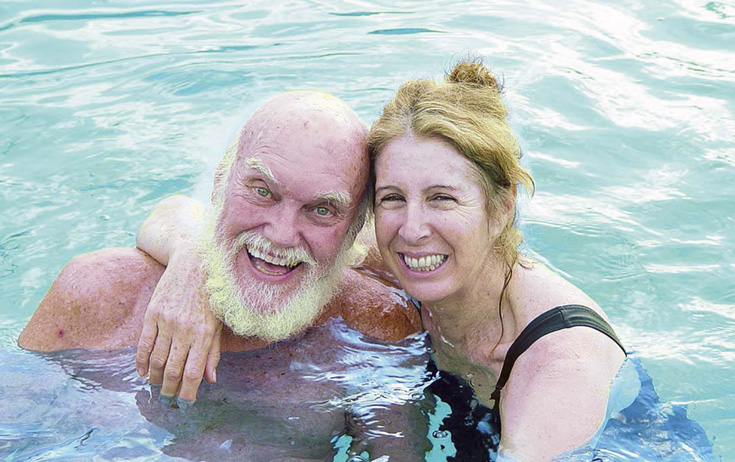
The news was posted instantly on social media, and within hours there was an outpouring of love, sadness, and gratitude from around the world. Almost every person who does yoga or has a spiritual practice today was influenced, directly or indirectly, by Ram Dass. He insisted to the end, however, that he was not a guru. On one of our visits, he told me he sometimes sees himself as “the kindergarten teacher,” who’d taken people on their first steps along the path. “But I’m not a guru.”
Why? I’d asked.
“The guru is God-realized and clear. He has no attachments and nothing in his personality is in the way.”
“Would you like to become realized in this life?” I asked.
He shut his eyes, letting the question sink in, waiting for the truth, not just a quick response. After a time, he said, “Yes,” and opened his eyes. “Then I would be able to help people so much.” He nodded. “So much.”
I saw that, for me, being realized had meant becoming free from the wheel of suffering. But for Ram Dass, and in other spiritual traditions, one who becomes enlightened chooses to turn back to the world, to incarnate again in order to help others. Until everyone is free. Everyone.
